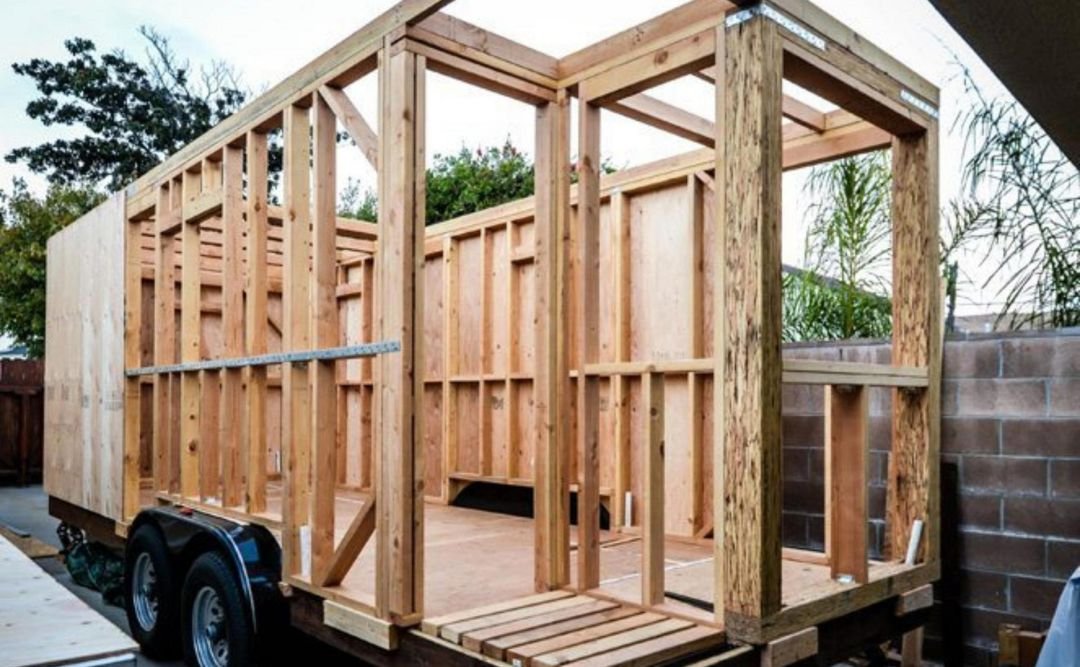Are you dreaming of creating the perfect tiny house? One of the most important elements to consider is the design of your walls. In this comprehensive guide, we will take you through all the steps to make your tiny house walls not only functional but also aesthetically pleasing.
From choosing the right materials and insulation options to planning the layout and incorporating storage solutions, we have got you covered.
In the first section, we will delve into the purpose of tiny house walls. Understanding their significance will help you make informed decisions throughout the design process.
Next, we will guide you in selecting the right materials for your walls, taking into account factors such as durability, weight, and cost.
Energy efficiency is a crucial aspect of any tiny house, so we will discuss various insulation options that can help you maintain a comfortable living space while minimizing energy consumption.
As you plan the layout of your walls, we will provide expert tips on optimizing space and creating a functional flow within your tiny house.
Additionally, we will explore creative ways to incorporate storage solutions into your wall design, maximizing every inch of your limited space.
To ensure a quieter living space, we will share soundproofing techniques that will make your tiny house a peaceful oasis.
The colors and textures you choose for your walls can greatly impact the overall atmosphere of your tiny house, so we will offer guidance on selecting the right ones to achieve your desired look and feel.
For those who enjoy hands-on projects, we will provide tips for DIYers on installing and finishing your tiny house walls with precision and skill.
Finally, we will inspire you with unique wall designs from around the world, helping you find the perfect inspiration for your own tiny house.
Get ready to transform your tiny house walls and create a space that is both functional and beautiful.
Key Takeaways
Contents
- 1 Understanding the Purpose of Tiny House Walls
- 2 Choosing the Right Materials for Your Tiny House Walls
- 3 Considering Insulation Options for Energy Efficiency
- 4 Planning the Layout of Your Tiny House Walls
- 5 Incorporating Storage Solutions into Your Wall Design
- 6 Maximizing Natural Light with Windows and Skylights
- 7 Creating a Functional and Versatile Wall System
- 8 Incorporating Built-in Furniture and Appliances
- 9 Adding Personality and Style with Wall Finishes
- 10 Incorporating Smart Home Technology into Your Walls
- 11 Ensuring Structural Integrity and Safety
- 12 Soundproofing Techniques for a Quieter Living Space
- 13 Choosing the Right Colors and Textures for Your Walls
- 14 Tips for DIYers: Installing and Finishing Your Tiny House Walls
- 15 Finding Inspiration and Ideas for Unique Wall Designs
- 16 Conclusion
Understanding the Purpose of Tiny House Walls

You may be wondering why understanding the purpose of tiny house walls is crucial in achieving the perfect design. Well, let me tell you, the walls of a tiny house serve more than just an aesthetic purpose. They play a vital role in the overall functionality and efficiency of the space.
One key aspect to consider is the importance of wall thickness. In a tiny house, every inch counts, and the thickness of the walls can have a significant impact on the available interior space. Thicker walls can reduce the usable square footage, while thinner walls can maximize the living area. By understanding the implications of wall thickness, you can make informed decisions that will optimize the layout of your tiny house.
Another crucial factor to consider is the impact of wall design on the interior space. The design of the walls can greatly influence the overall feel and functionality of your tiny house. For instance, using lighter colors and materials for the walls can create an illusion of spaciousness, making the tiny house feel more open and airy. On the other hand, darker colors and textured materials can add depth and warmth to the space.
Additionally, incorporating built-in storage solutions within the walls can help maximize the available storage space, keeping your tiny house clutter-free and organized. By carefully considering the design of your tiny house walls, you can create a space that not only looks beautiful but also maximizes every square inch to its full potential.
Choosing the Right Materials for Your Tiny House Walls
When it comes to creating the ideal walls for your little abode, it’s crucial to select the right materials. Not only do you want your walls to be sturdy and reliable, but you also want them to reflect your personal style and create a cozy atmosphere.
One option to consider is using eco-friendly materials for your tiny house walls. Not only will this choice be better for the environment, but it can also add a unique and natural touch to your space. Some eco-friendly materials to consider include reclaimed wood, bamboo, and cork. These materials not only look beautiful, but they also have a smaller carbon footprint and can help create a healthier indoor environment.
In addition to choosing eco-friendly materials, you can also get creative with inspiring wall decor in your tiny house. Since space is limited, it’s important to make the most of every square inch, including your walls.
Consider using floating shelves to display plants, books, or other decorative items. You can also incorporate wall-mounted artwork, such as paintings or photographs, to add a personal touch to your space. Another idea is to create a gallery wall using a mix of framed artwork and photographs. This can be a great way to showcase your favorite memories and add visual interest to your tiny house walls.
By combining eco-friendly materials and inspiring wall decor, you can create the perfect walls for your tiny house that are both beautiful and sustainable.
Considering Insulation Options for Energy Efficiency
To optimize the energy efficiency of your tiny home, it’s important to consider different insulation options. Proper insulation installation can significantly reduce heat loss or gain, making your tiny house more comfortable and cost-effective to heat or cool.
There are various cost-effective insulation options available that can help you achieve the perfect balance between energy efficiency and affordability.
One popular insulation choice for tiny house walls is spray foam insulation. This type of insulation is applied as a liquid and expands to fill all the nooks and crannies, creating a seamless barrier against air leakage. Spray foam insulation provides excellent thermal resistance, helping to keep your tiny house warm in the winter and cool in the summer. It also acts as a sound barrier, reducing noise from outside. Although spray foam insulation can be more expensive upfront, it offers long-term energy savings and may even qualify you for tax credits or rebates.
Another cost-effective insulation option is fiberglass insulation. This type of insulation consists of tiny glass fibers that trap air pockets, providing excellent thermal resistance. Fiberglass insulation is relatively easy to install and can be a budget-friendly choice for tiny house owners. It is essential to ensure proper installation to avoid gaps or compression, as this can reduce its effectiveness. Additionally, fiberglass insulation is non-combustible and resistant to mold and mildew growth, making it a safe and durable option for your tiny house walls.
Consider these insulation options carefully to find the perfect fit for your tiny house. By choosing the right insulation and ensuring proper installation, you can create a comfortable and energy-efficient living space while keeping costs in check.
Planning the Layout of Your Tiny House Walls
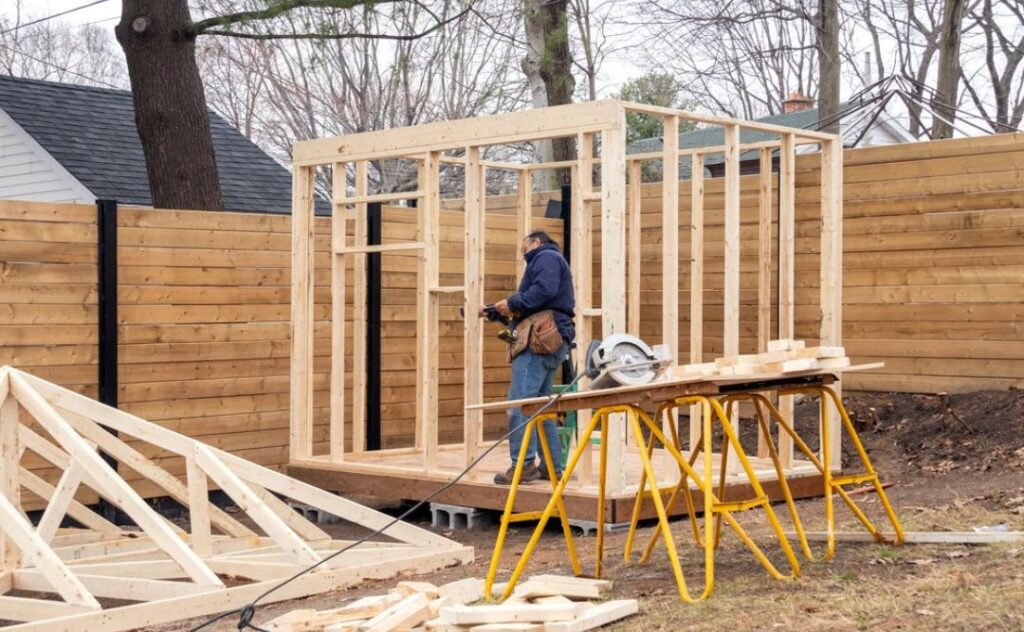
Creating an efficient and functional layout for your tiny house walls is crucial for maximizing the limited space available. When planning the layout of your tiny house walls, it’s important to focus on layout optimization and space utilization. Here are some key considerations to keep in mind:
- Open Concept Design: Embrace the concept of open spaces by minimizing the number of internal walls. This will create a sense of spaciousness and allow for flexible use of the available area. Consider using multifunctional furniture and built-in storage solutions to maximize the usability of the space.
- Smart Storage Solutions: Utilize every nook and cranny by incorporating clever storage solutions into your wall design. Install floating shelves, built-in cabinets, and vertical storage units to make the most of the vertical space. Additionally, consider incorporating hidden storage compartments within the walls themselves to keep your tiny house clutter-free.
When planning the layout of your tiny house walls, think outside the box and get creative with your space utilization. By optimizing the layout and incorporating smart storage solutions, you can make the most of the limited space available in your tiny house. Remember, every square inch counts!
Incorporating Storage Solutions into Your Wall Design
One way to maximize the functionality of your small space is by incorporating clever storage solutions into the design of your walls. In a tiny house, where every square inch counts, utilizing vertical space is key. Consider installing floor-to-ceiling shelves or cabinets that can hold a multitude of items, from books and decorative trinkets to kitchen supplies and clothing.
These vertical storage solutions not only provide ample space to keep your belongings organized, but they also help to visually elongate the room, making it appear larger and more open. Get creative with your shelving by incorporating unique shapes and sizes that add a touch of personality to your tiny house walls. You can opt for floating shelves that are mounted directly onto the wall, or choose modular shelving units that can be rearranged and customized to fit your specific storage needs.
By thinking outside the box and maximizing your wall space, you can create a functional and stylish storage solution that perfectly suits your tiny house lifestyle.
Another innovative way to incorporate storage into your tiny house walls is by using hidden compartments and built-in features. Consider installing hidden cabinets or drawers behind wall panels or under stairs. These secret storage spaces can be used to store items that you don’t need access to on a daily basis, such as seasonal clothing or extra bedding.
Additionally, you can incorporate built-in features like hooks, racks, and hangers directly onto your walls to hang items such as coats, hats, and bags. This not only keeps your belongings organized and easily accessible, but it also helps to maximize floor space, making your tiny house feel more open and clutter-free.
Remember to carefully plan the layout and design of your tiny house walls to make the most of the available space and ensure that your storage solutions seamlessly blend with the overall aesthetic of your home.
Maximizing Natural Light with Windows and Skylights
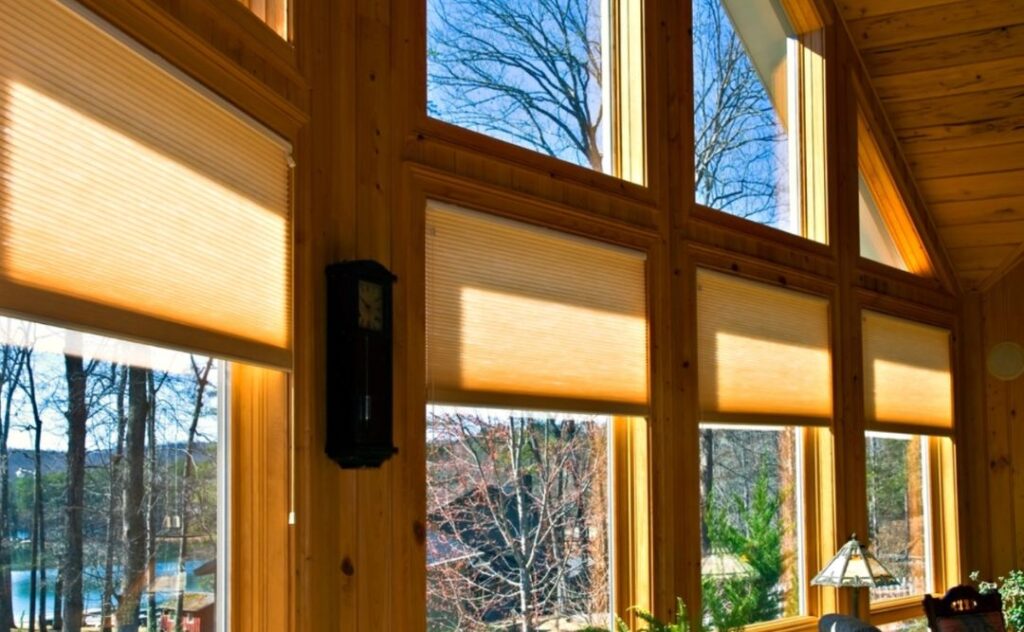
Imagine the warm glow of sunlight streaming through the windows and skylights, filling your space with natural light and creating a cozy and inviting atmosphere. Maximizing natural light is essential when designing your tiny house walls, as it can make your space feel larger, brighter, and more open. Strategically placing windows and skylights throughout your tiny house can greatly enhance the overall aesthetic and functionality of your living space.
When it comes to window placement, it’s important to consider both the practical and aesthetic aspects. Think about the orientation of your tiny house and the path of the sun throughout the day. Placing windows on the south-facing side will allow for maximum sunlight exposure, while windows on the east and west sides can provide beautiful morning and evening light. Additionally, incorporating larger windows in the common areas, such as the living room and kitchen, will create a sense of spaciousness and connection to the outdoors.
To help you visualize the impact of window placement on your tiny house walls, here is a table showcasing different possibilities:
| Window Placement | Benefits |
| South-facing windows | Maximize sunlight exposure throughout the day |
| East-facing windows | Beautiful morning light |
| West-facing windows | Gorgeous evening light |
| Larger windows in common areas | Create a sense of spaciousness and connection to the outdoors |
By strategically placing windows and skylights in your tiny house walls, you can maximize natural light and create a bright and airy living space. Remember to consider the orientation of your tiny house and the path of the sun when deciding on window placement. With the right design, your tiny house walls will not only be functional but also aesthetically pleasing, making your tiny home a truly delightful place to live.
Creating a Functional and Versatile Wall System
Now that you’ve learned how to maximize natural light in your tiny house with windows and skylights, it’s time to dive into creating a functional and versatile wall system.
When it comes to designing the perfect tiny house walls, it’s important to consider the layout that will best suit your needs while also saving precious space.
One of the key elements in a functional wall layout is utilizing space-saving wall solutions. In a tiny house, every square inch matters, so it’s crucial to make the most of the available space. Consider incorporating features like built-in storage units, foldable furniture, and multifunctional elements that can serve multiple purposes. This will allow you to maximize the functionality of your walls, making them not only aesthetically pleasing but also practical and efficient.
Additionally, when designing your tiny house walls, think about how you can make them adaptable and versatile. Opt for modular wall systems that can be easily reconfigured or adjusted based on your changing needs. This will give you the flexibility to adapt your space as you grow or if your living situation changes.
By creating a wall system that is both functional and versatile, you’ll be able to make the most of your tiny house while still maintaining a stylish and comfortable living environment.
Incorporating Built-in Furniture and Appliances
To really take your tiny house to the next level, you’ll want to incorporate some built-in furniture and appliances that will make your space feel both luxurious and efficient. One of the key advantages of tiny house living is maximizing storage space, and built-in storage solutions are the perfect way to achieve this. Consider incorporating cabinets, shelves, and drawers into your walls to create seamless storage that doesn’t take up valuable floor space. These built-in storage solutions can be customized to fit your specific needs, whether you’re looking to store clothing, kitchen supplies, or even a hidden workspace.
In addition to storage, space-saving appliances are essential in a tiny house. Look for appliances that are compact and multi-functional, such as a combination washer-dryer or an all-in-one kitchen unit. These appliances not only save space but also streamline your daily tasks. Imagine having a washer and dryer tucked away in a closet or a kitchen unit that includes a stove, sink, and refrigerator all in one compact design. By incorporating these space-saving appliances, you can have all the functionality of a traditional home without sacrificing space or style.
| Built-in Furniture | Space-Saving Appliances |
| Custom Cabinets | Combination Washer-Dryer |
| Wall Shelves | All-in-One Kitchen Unit |
| Built-in Drawers | Compact Stove |
| Hidden Workspace | Integrated Refrigerator |
With the right built-in furniture and appliances, your tiny house walls can become more than just structural elements; they can become functional and versatile components of your living space. Take the time to plan and design these elements carefully, considering both your storage needs and the space-saving potential of each piece. By incorporating built-in storage solutions and space-saving appliances, you can create a tiny house that not only looks great but also maximizes functionality and efficiency.
Adding Personality and Style with Wall Finishes
Transform your tiny house into a vibrant and personalized space by adding your unique touch with creative and stylish wall finishes. Adding texture to your walls is a great way to make them visually interesting and add depth to your space.
Consider using materials like reclaimed wood paneling or textured wall tiles to create a rustic or industrial look. Another option is to use wallpaper with a textured pattern, such as faux brick or stone, to give your walls a realistic and unique appearance. The texture will not only add visual interest but also create a sense of warmth and coziness in your tiny house.
In addition to texture, using wallpaper is another fantastic way to add personality and style to your tiny house walls. Wallpaper comes in a variety of patterns, colors, and textures, allowing you to find the perfect design that suits your taste.
Opt for bold and vibrant patterns to create a statement wall or choose subtle and delicate prints for a more serene and calming atmosphere. Wallpaper can also be used to create an accent wall, adding a focal point to your space.
Whether you prefer a modern geometric design or a vintage floral pattern, wallpaper is a versatile and easy way to transform the look and feel of your tiny house walls.
Incorporating Smart Home Technology into Your Walls

By seamlessly integrating smart home technology into your walls, you can elevate your tiny house living experience to a whole new level of convenience and efficiency. Smart home automation allows you to control various aspects of your house with just a touch of a button or a simple voice command.
Imagine being able to adjust the lighting, temperature, and even the security of your tiny house without having to physically do it yourself. With energy efficient technology, you can also minimize your carbon footprint and reduce your energy bills. Smart thermostats can learn your preferences and automatically adjust the temperature to optimize energy usage. Motion sensors can turn off lights in unoccupied rooms, and smart plugs can monitor and control the energy consumption of your appliances.
By incorporating these smart home features into your walls, you can create a truly efficient and sustainable living space.
In addition to the practical benefits, incorporating smart home technology into your walls can also enhance the aesthetic appeal of your tiny house. With wireless speakers hidden within the walls, you can enjoy high-quality audio without the clutter of visible speakers. You can also install motorized blinds or curtains that can be controlled remotely, adding a touch of elegance and convenience to your space.
Another exciting feature is the ability to create personalized lighting scenes. With smart light bulbs and dimmers, you can easily adjust the brightness and color of your lights to create the perfect ambiance for any occasion. Whether you want a cozy atmosphere for a movie night or a vibrant setting for a party, smart home technology allows you to effortlessly transform your tiny house walls into a dynamic and versatile canvas.
Ensuring Structural Integrity and Safety
Ensuring the structural integrity and safety of your smart home technology integration is crucial for a worry-free living experience. When designing the walls of your tiny house, it’s essential to consider the structural reinforcement needed to support the weight of your smart home devices.
These devices may include cameras, speakers, and sensors, which can add extra weight to your walls. Incorporating additional support beams or using reinforced framing techniques can help distribute the load evenly and prevent any potential structural issues in the future.
In addition to structural reinforcement, it’s important to prioritize fire safety measures in your tiny house walls design. Since smart home technology often relies on electrical components, there’s an increased risk of fire hazards. To mitigate this risk, consider using fire-resistant materials for your walls, such as fire-rated drywall or cement board.
These materials can provide an extra layer of protection and help contain any potential fire incidents. Additionally, ensure that all electrical wiring is done by a licensed professional and meets the necessary safety codes.
By taking these precautions, you can enjoy the benefits of smart home technology while keeping your tiny house safe and secure.
Soundproofing Techniques for a Quieter Living Space
Create a peaceful oasis within your home by implementing effective soundproofing techniques. When designing the walls of your tiny house, it is important to prioritize soundproofing to ensure a quieter and more comfortable living space. One effective method is to install acoustic panels, which are designed to absorb and reduce sound vibrations. These panels can be strategically placed on the walls to minimize noise transfer from both outside and inside the house. Additionally, consider using double glazing for your windows, which involves using two layers of glass with an air gap in between. This technique helps to block out external noise and provides better insulation, making your tiny house quieter and more energy-efficient.
By incorporating these soundproofing techniques, you can create a quieter living space in your tiny house. Acoustic panels and double glazing are effective solutions to minimize noise transfer and enhance the overall acoustics of your home. Remember to consider the installation process, aesthetics, and maintenance requirements when implementing these techniques to ensure the best results. With a well-designed soundproofing strategy, you can enjoy a peaceful and serene environment in your tiny house.
Choosing the Right Colors and Textures for Your Walls
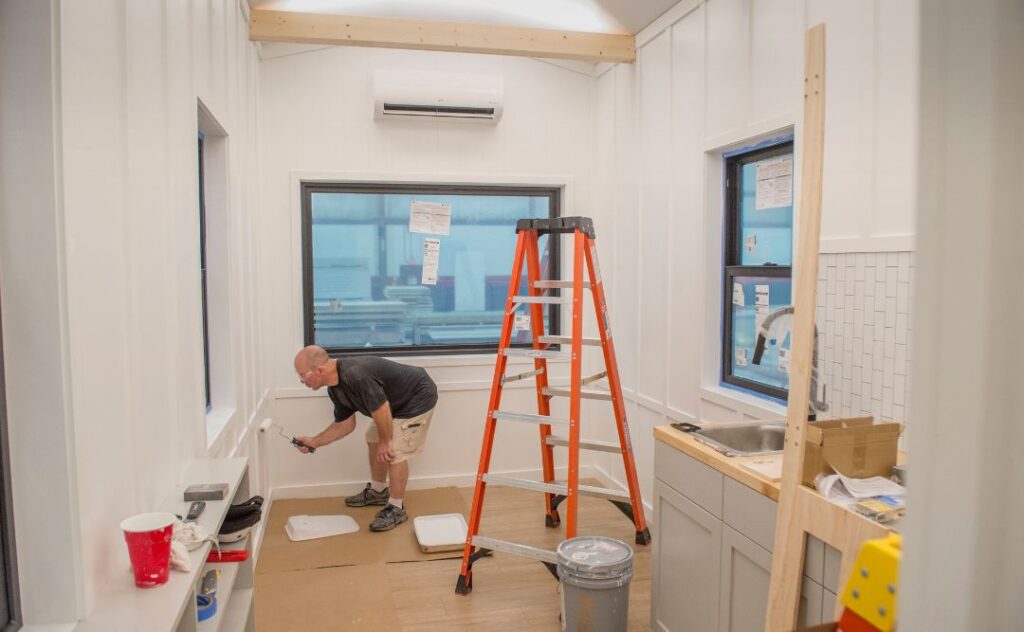
Transform your living space into a vibrant and inviting oasis by carefully selecting colors and textures for your walls.
Choosing the right paint colors can make a huge difference in the overall atmosphere of your tiny house. Opt for light and neutral shades such as whites, creams, and grays to create a sense of openness and airiness. These colors also have the added benefit of reflecting natural light, making your space feel brighter and more spacious.
If you want to add a pop of color, consider using accent walls or incorporating bold hues through artwork or furniture. This will allow you to inject personality and style into your tiny house without overwhelming the space.
In addition to paint, exploring different wallpaper options can also add texture and visual interest to your walls. Wallpaper has come a long way in recent years, with a wide variety of styles and patterns available. Consider using textured wallpaper to add depth and dimension to your walls. You can also opt for wallpapers that mimic natural materials such as wood or brick, giving your tiny house a rustic and cozy feel.
Don’t be afraid to mix and match different patterns and textures to create a unique and personalized look. Just remember to keep the scale of the patterns in mind, as too many bold or busy patterns can make your space feel cluttered.
By carefully choosing paint colors and exploring different wallpaper options, you can transform your tiny house walls into a visually stunning and inviting space.
Tips for DIYers: Installing and Finishing Your Tiny House Walls
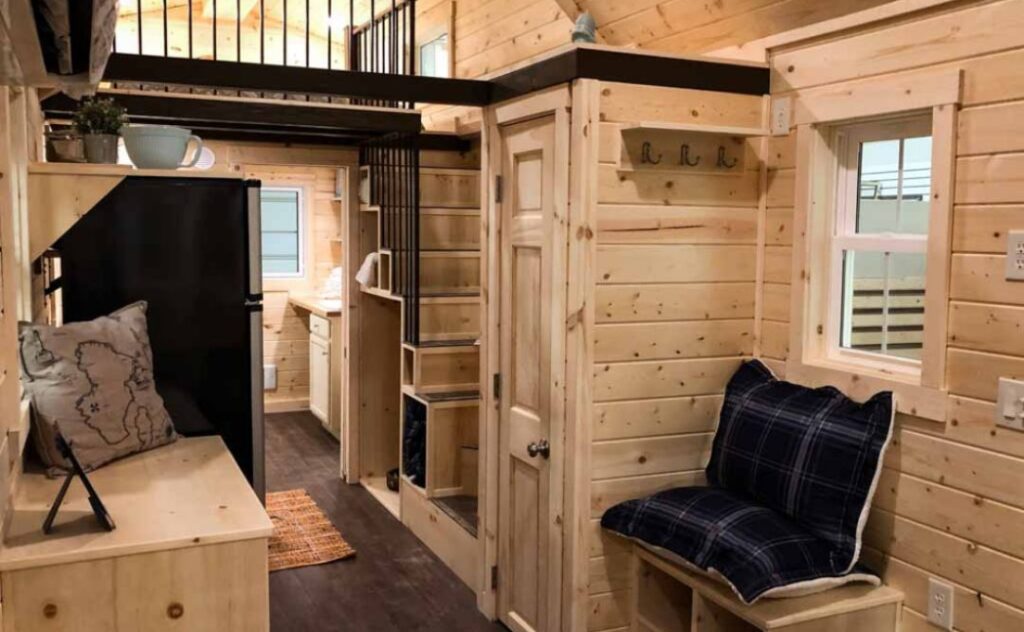
Now that you have chosen the perfect colors and textures for your tiny house walls, it’s time to roll up your sleeves and get to work! In this section, we will provide you with some valuable tips for installing and finishing your walls, so you can achieve that picture-perfect look you’ve been dreaming of. Whether you’re a seasoned DIYer or a beginner, these tips will help you navigate through the process with ease.
First and foremost, let’s talk about installing your walls. It’s essential to start with a solid foundation, so make sure your framing is sturdy and level before you begin. Measure and cut your panels carefully, ensuring a snug fit. Use screws rather than nails for a more secure hold, and be sure to space them evenly to prevent any warping or bulging. Once your panels are in place, it’s time to move on to the finishing touches. Sand any rough edges or imperfections, and fill any gaps or cracks with putty. Then, it’s time to prime and paint! For a flawless finish, be sure to follow the manufacturer’s instructions and apply multiple thin coats, allowing each coat to dry completely before moving on to the next.
As you embark on this journey of creating the perfect tiny house walls, it’s important to keep in mind that budget-friendly options are available for both painting and wall decor. To help you make the most of your resources, we have prepared a handy table with four budget-friendly wall decor ideas and tips for painting your tiny house walls. This table will not only engage you but also provide you with practical solutions to enhance the aesthetics of your tiny house while staying within your budget. So, let’s dive in and explore the wonderful world of DIY wall decor and painting tips!
| Wall Decor Ideas | Tips for Painting Tiny House Walls |
| 1. Upcycled Materials | 1. Use high-quality, low VOC paint for a healthier indoor environment. |
| 2. Gallery Wall | 2. Prep your walls properly by cleaning and priming them before painting. |
| 3. DIY Wall Art | 3. Invest in good quality brushes and rollers for a smoother finish. |
| 4. Removable Wallpaper | 4. Consider using a paint sprayer for faster and more even coverage. |
With these tips and ideas, you can now confidently tackle the installation and finishing of your tiny house walls. Remember, attention to detail and patience are key to achieving a professional-looking result. So, put on your DIY hat and let your creativity shine as you transform your tiny house into a cozy and stylish retreat!
Finding Inspiration and Ideas for Unique Wall Designs
Seeking inspiration for your wall designs can be a thrilling adventure, offering a plethora of unique and imaginative ideas to transform your tiny house into a captivating space. When it comes to wall art ideas and DIY wall treatments, the possibilities are endless.
Here are a few ideas to get your creative juices flowing:
- Gallery Wall: Create a gallery wall by displaying a collection of your favorite artwork, photographs, or even vintage finds. Mix and match different sizes and styles of frames to add visual interest and personality to your walls.
- Textured Wallpaper: Consider using textured wallpaper to add depth and dimension to your tiny house walls. Whether you prefer a subtle textured pattern or a bold geometric design, textured wallpaper can instantly elevate the look of your space.
- Natural Materials: Incorporate natural materials like reclaimed wood, stone, or even plants into your wall design. These elements not only add a touch of nature to your tiny house but also bring warmth and texture to the overall aesthetic.
With these wall art ideas and DIY wall treatments, you can create a truly unique and personalized space in your tiny house. Let your imagination run wild and have fun experimenting with different designs and materials to make your walls a true reflection of your style and personality.
Conclusion
Congratulations! You’ve reached the end of this comprehensive guide on how to create the perfect design for your tiny house walls. Hopefully, throughout this journey, you’ve gained a deeper understanding of the importance of walls in a tiny house and how they can greatly enhance your living experience.
By carefully choosing the right materials and considering insulation options, you can create a space that’s not only energy-efficient but also comfortable. Planning the layout of your walls and incorporating storage solutions will help maximize the limited space available, while soundproofing techniques will ensure a quieter and more peaceful living environment.
Now, let’s talk about the aesthetics of your tiny house walls. Choosing the right colors and textures will add personality and character to your space. Whether you prefer a minimalist and sleek look or a cozy and rustic feel, the possibilities are endless. Let your creativity run wild and create a wall design that truly reflects your style and taste.
For those of you who are DIY enthusiasts, we’ve provided tips on how to install and finish your tiny house walls. Remember, attention to detail is key here. Take your time, follow the steps carefully, and soon enough, you’ll have walls that are not only functional but also visually appealing.
Lastly, if you’re in need of inspiration and ideas for unique wall designs, don’t fret. There are countless resources available online, from blogs and forums to social media platforms, where you can find an array of innovative and creative wall designs. So go ahead and explore, and let your imagination soar!
In conclusion, creating the perfect design for your tiny house walls is a combination of functionality, aesthetics, and personal preference. With the right materials, insulation, layout, storage solutions, soundproofing techniques, colors, and textures, you can transform your tiny house into a cozy and inviting sanctuary. So roll up your sleeves, get creative, and start designing your dream tiny house walls today!

